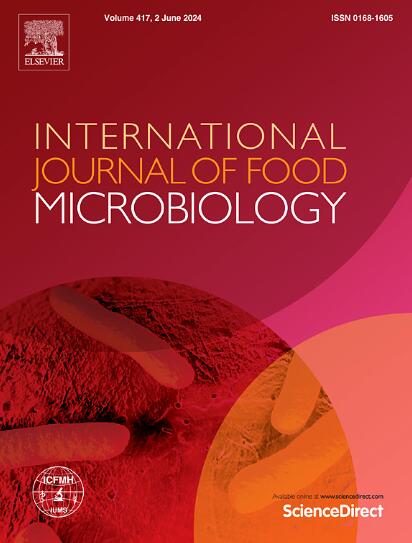混凝菌CGMCC 9951挥发性有机物对红薯采后丝状角鼻虫的抑菌活性及其生物防治潜力
IF 5.2
1区 农林科学
Q1 FOOD SCIENCE & TECHNOLOGY
International journal of food microbiology
Pub Date : 2025-05-23
DOI:10.1016/j.ijfoodmicro.2025.111281
引用次数: 0
摘要
微生物产生的挥发性有机化合物(VOCs)被认为是治理红薯采后黑斑病的潜在生态友好型熏蒸剂。本研究旨在评价魏兹曼凝血剂CGMCC 9951 VOCs对毛角鼻虫的抑制作用。结果表明,在体外和体内均能有效抑制毛霉。GC-MS分析表明,挥发性有机化合物主要为苯甲醇、丁香酚、醋酸异戊酯、芳樟醇和苯并噻唑。其中,芳樟醇和苯并噻唑对毛霉的抑制作用最显著。经挥发性有机化合物处理的甘薯黑斑的大小和深度显著减小。转录组分析和荧光显微镜显示,VOCs可以显著下调与孢子萌发、细胞壁完整性、DNA复制和修复以及致病性相关的基因的表达。综上所述,W.凝固菌CGMCC 9951挥发性有机化合物对红薯采后具有有效的保护作用。本文章由计算机程序翻译,如有差异,请以英文原文为准。
Antifungal activity of volatile organic compounds produced by Weizmannia coagulans CGMCC 9951 on Ceratocystis fimbriata in postharvest sweet potatoes and its potential biocontrol
Volatile organic compounds (VOCs) produced by microorganisms are regarded as potential eco-friendly fumigants for managing black spot disease in postharvest sweet potatoes. This study aimed to assess the efficacy of Weizmannia coagulans CGMCC 9951 VOCs in inhibiting Ceratocystis fimbriata. The findings indicated that C. fimbriata was effectively inhibited both in vitro and in vivo. The GC–MS analysis revealed that the VOCs primarily consist of Benzyl alcohol, Eugenol, Isoamyl acetate, Linalool, and Benzothiazole. Among these, Linalool and Benzothiazole exhibited the most significant inhibitory effects against C. fimbriata. Sweet potatoes treated with VOCs exhibited a significant decrease in the size and depth of black spots. Transcriptome analysis and fluorescence microscopy demonstrated that VOCs could substantially down-regulate the expression of genes associated with spore germination, cell wall integrity, DNA replication and repair, and pathogenicity. These results suggest that W. coagulans CGMCC 9951 VOCs effectively inhibit C. fimbriata and protect postharvest sweet potatoes.
求助全文
通过发布文献求助,成功后即可免费获取论文全文。
去求助
来源期刊
CiteScore
10.40
自引率
5.60%
发文量
322
审稿时长
65 days
期刊介绍:
The International Journal of Food Microbiology publishes papers dealing with all aspects of food microbiology. Articles must present information that is novel, has high impact and interest, and is of high scientific quality. They should provide scientific or technological advancement in the specific field of interest of the journal and enhance its strong international reputation. Preliminary or confirmatory results as well as contributions not strictly related to food microbiology will not be considered for publication.

 求助内容:
求助内容: 应助结果提醒方式:
应助结果提醒方式:


